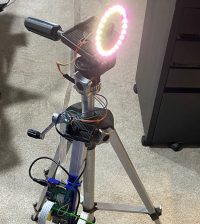- How to Adjust X and Y Axis Scale in Arduino Serial Plotter (No Extra Software Needed)Posted 3 months ago
- Elettronici Entusiasti: Inspiring Makers at Maker Faire Rome 2024Posted 3 months ago
- makeITcircular 2024 content launched – Part of Maker Faire Rome 2024Posted 5 months ago
- Application For Maker Faire Rome 2024: Deadline June 20thPosted 7 months ago
- Building a 3D Digital Clock with ArduinoPosted 12 months ago
- Creating a controller for Minecraft with realistic body movements using ArduinoPosted 1 year ago
- Snowflake with ArduinoPosted 1 year ago
- Holographic Christmas TreePosted 1 year ago
- Segstick: Build Your Own Self-Balancing Vehicle in Just 2 Days with ArduinoPosted 1 year ago
- ZSWatch: An Open-Source Smartwatch Project Based on the Zephyr Operating SystemPosted 1 year ago
DIY a Raspberry Pi Vintage Spotify Radio

Inpired by the 1938 Emerson AX212 radio, the maker Tinkernut decided to make a Spotify streaming radio, but with a bit of flare. It looks like a retro radio with working knobs that displays the album art of the song that’s currently playing.
The Raspberry Pi Zero W is an incredible bite-sized linux computer that opens the door to so many cool projects and possibilities: it’s perfect for this 3d printed radio.
All you need is:
- Raspberry Pi Zero Wireless
- Raspberry Pi Raspbian OS
- Adafruit Raspberry Pi “Bonnet”
- Adafruit 1.8″ Color TFT LCD Display7
- Adafruit I2S Mono Amplifier – MAX98357A
- Speaker: 3W, 4 ohms
- Rotary Encoder with Push-Button
- Ultra-Slim 2500mah Power Bank
- Slide Switch
- Hookup Wire
- 3d printer (for the case)
Once you have installed the Raspbian OS on your Pi Zero, you have to connect the pre-made amp chip Adafruit MAX 98357 to the Pi using the Adafruit perma-proto “bonnet” for the Pi Zero. You can use any generic proto-board that you want, but he found that this one made connecting things to the Pi very easy. After that, you can connect a speaker to it. The type of speaker you use really depends on the quality you want.
The key to make this streaming radio stand out and give it a unique touch is to have a screen that displays the album art of the current song that is playing. You can go with a larger LCD if you want, but to keep this project small, this 1.8″ should work fine. This screen as well can be powered through the Raspberry Pi GPIO pins. So now the Pi, the amp, and the LCD screen can all be powered through a single source and can be self contained.
Thanks to Mopidy, which is a python based music playing application for the Raspberry Pi, It can play music from several sources, including locally, Google Music, Soundcloud, and of course Spotify.
Click here for a full overview of this interesting project.















